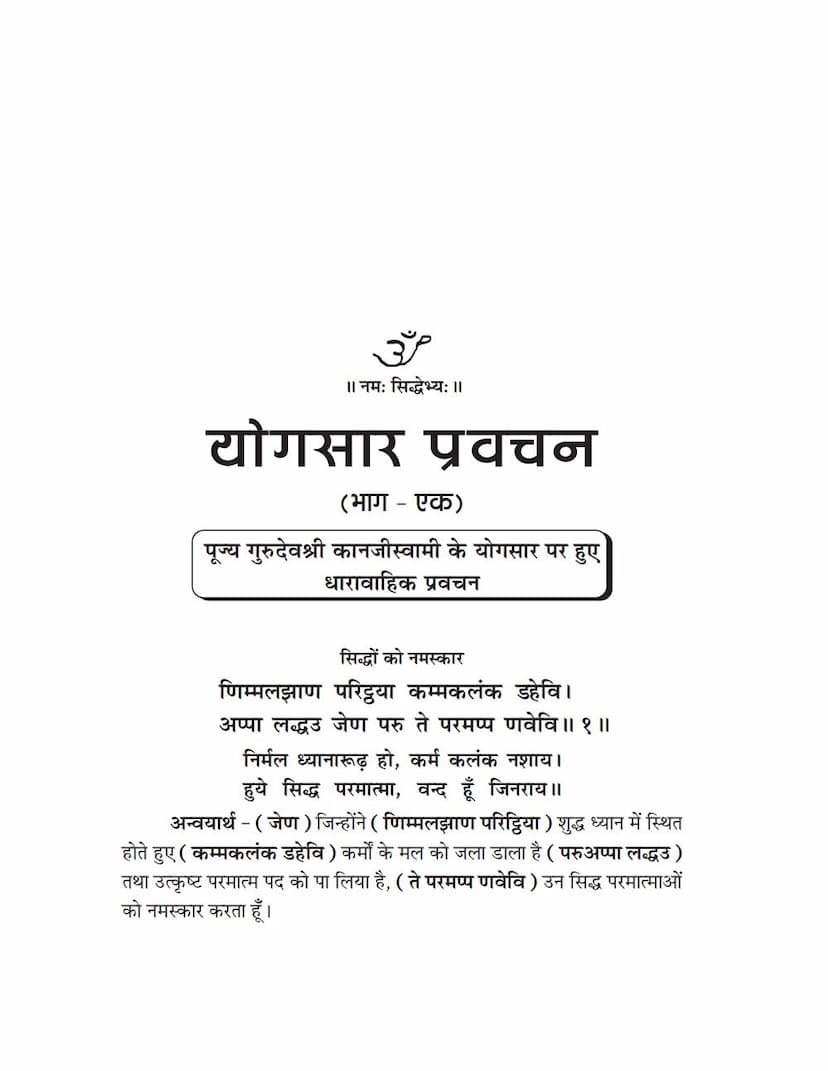Yogsara Pravachan Part 01
Added to library: September 2, 2025

Summary
This is a comprehensive summary of "Yogsara Pravachan Part 01" by Devendra Jain, based on the provided text:
Book Title: Yogsara Pravachan Part 01 Author(s): Devendra Jain (based on the discourses of Pujya Gurudev Shri Kanji Swami) Publisher: Kundkund Kahan Parmarthik Trust
This volume contains the first part of the discourses by Pujya Gurudev Shri Kanji Swami on the Yogsara text. The primary aim of the Yogsara is to guide individuals towards realizing their true spiritual nature and achieving liberation from the cycle of birth and death.
Key Themes and Concepts:
- The Nature of the Soul (Atma): The text emphasizes that the soul is inherently pure, conscious, and blissful, akin to the state of the liberated souls (Siddhas). The true nature of the soul is identified with knowledge, perception, and conduct, leading to the manifestation of the Siddha state.
- The Path of Yoga (Yogsara): The "Yogsara" itself is described as the practice of uniting the soul with its true essence through introspection and spiritual discipline. This involves internal contemplation and the realization of the soul's intrinsic nature, leading to the manifestation of the pure, blissful, and liberated state.
- Rejection of External Rituals for Liberation: A central theme is the understanding that true liberation (Moksha) is not achieved through external rituals, austerities, or good deeds (like charity or kindness) alone. These are considered "perbhav" (external states) and, while potentially leading to heavenly realms, do not grant ultimate liberation. The focus is consistently on internal purification and self-realization.
- The Importance of Right Faith, Knowledge, and Conduct (Samyak Darshan, Gyan, Charitra): The path to liberation is understood as the attainment of true faith (Samyak Darshan) in the soul's pure nature, followed by right knowledge (Samyak Gyan) and right conduct (Samyak Charitra) through introspection and adherence to Jain principles.
- The Meaning of Moksha: Moksha is described as the state of being free from all karmic impurities, leading to an eternal, blissful, and omniscient existence, like that of the Siddhas.
- Critique of Ignorance and Attachment: The text strongly criticizes ignorance (Mithyatva) and attachment to external things, including the body, worldly possessions, and even virtuous actions performed with an egoistic bent. These are seen as impediments to spiritual progress and the cause of continued suffering and transmigration.
- The Three Souls (Bahiātmā, Antarātmā, Paramātmā): The text differentiates between the outward-focused individual (Bahiātmā), who identifies with the external world and actions; the inner-focused individual (Antarātmā), who begins to realize the soul's nature; and the Supreme Soul (Paramātmā), who has fully realized their true self.
- The Cause of Samsara: Ignorance (Mithyatva) is identified as the root cause of being trapped in the cycle of birth and death (Samsara). This ignorance leads to attachment and a mistaken identification with external states.
- The Nature of Karma: Karma is understood as the impurity that obscures the soul's true nature. The discourse emphasizes that through spiritual practice and the destruction of karmic matter, one can achieve liberation.
- The Efficacy of Self-Realization: The ultimate goal is to realize the soul as it truly is – pure, eternal, and blissful. This self-realization, achieved through introspection and unwavering focus on the soul, is the direct path to liberation.
- Critique of Ritualistic Practices without Inner Understanding: The discourses repeatedly stress that performing rituals, austerities, or adhering to external practices without the core understanding of the soul's nature and the true spiritual path is futile and does not lead to liberation. The emphasis is on the internal realization rather than external display.
- The Meaning of "Yog": The term "Yog" is explained not as external physical postures but as the union of consciousness with the soul's true nature. It's about engaging the soul's consciousness with its own intrinsic qualities.
Structure of the Discourses:
The discourses are presented verse by verse (Gatha by Gatha), with the explanation of each verse delving into the philosophical and practical aspects of Jainism. The initial verses often focus on invoking the liberated souls (Siddhas) as a form of auspicious beginning (Mangal) and establishing the fundamental nature of the soul. The subsequent verses progressively elaborate on the path, the obstacles, and the ultimate goal of Moksha.
Key Takeaways:
- Internal Focus: The Yogsara Pravachan consistently directs the listener inward, emphasizing that the true path to liberation lies within the soul itself, not in external actions or deities.
- Self-Reliance in Spiritual Practice: The discourses highlight that the soul is its own master and possesses the inherent capacity for liberation. The effort must come from within.
- The Ultimate Reality: The ultimate reality is the soul's pure, unadulterated, and liberated nature, which is attainable through diligent self-reflection and practice.
This summary provides a foundational understanding of the Yogsara Pravachan Part 01, highlighting its core teachings and the spiritual guidance offered by Pujya Gurudev Shri Kanji Swami. The detailed explanations within the text would offer deeper insights into the nuances of Jain philosophy and practice.